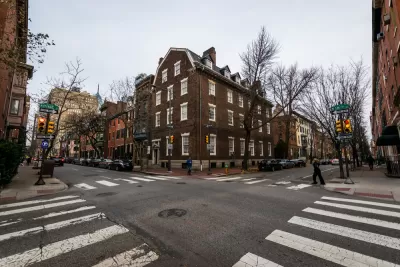The mayor, planning staff, and the Philadelphia Planning Commission agree. The Philadelphia City Council and residents of the wealthy neighborhood of Society Hill, not so much.

"Mayor Jim Kenney has once again vetoed a controversial zoning bill that sought to create a height ceiling in Philadelphia’s affluent Society Hill neighborhood," reports Ryan Briggs.
Planetizen picked up the news in September of legislation that the City Council would downzone the affluent neighborhood over the objections of planning staff and the Philadelphia Planning Commission. The legislation "would have limited development in the area to just 65 feet, or about six stories," according to Briggs.
To supplement the public information about the mayor's veto, Briggs has also obtained a letter from Mayor Kenney to the Society Hill Civic Association, which pushed for the zoning changes—in the letter, the mayor expresses support for a supply side approach to housing policy.
“Restricting overall development in Society Hill, the overlay will limit the supply of units necessary to meet housing demand,” Kenney said. “This will likely place undue pressure on surrounding communities to meet that demand, in turn driving housing prices higher and potentially displacing low-, moderate- and middle-income residents.”
In a previous article, Pat Loeb described the legislation thusly:
The bill would limit building height in the neighborhood, which runs from the Delaware River to 8th Street, between Walnut and Lombard. In some parts of it, buildings could not exceed 45 feet, limiting how much housing could be built there, decreasing the chances for creating mixed income units.
It also increases the number of parking spaces required for new development despite the city's goal of reducing private car use to relieve congestion, improve safety and fight climate change.
FULL STORY: Mayor Kenney vetoes Society Hill height limit

Planetizen Federal Action Tracker
A weekly monitor of how Trump’s orders and actions are impacting planners and planning in America.

Maui's Vacation Rental Debate Turns Ugly
Verbal attacks, misinformation campaigns and fistfights plague a high-stakes debate to convert thousands of vacation rentals into long-term housing.

Restaurant Patios Were a Pandemic Win — Why Were They so Hard to Keep?
Social distancing requirements and changes in travel patterns prompted cities to pilot new uses for street and sidewalk space. Then it got complicated.

Charlottesville Temporarily Has No Zoning Code
A judge ordered the Virginia city to throw out its newly revised zoning code, leaving permitting for new development in legal limbo.

In California Battle of Housing vs. Environment, Housing Just Won
A new state law significantly limits the power of CEQA, an environmental review law that served as a powerful tool for blocking new development.

Boulder Eliminates Parking Minimums Citywide
Officials estimate the cost of building a single underground parking space at up to $100,000.
Urban Design for Planners 1: Software Tools
This six-course series explores essential urban design concepts using open source software and equips planners with the tools they need to participate fully in the urban design process.
Planning for Universal Design
Learn the tools for implementing Universal Design in planning regulations.
Heyer Gruel & Associates PA
JM Goldson LLC
Custer County Colorado
City of Camden Redevelopment Agency
City of Astoria
Transportation Research & Education Center (TREC) at Portland State University
Jefferson Parish Government
Camden Redevelopment Agency
City of Claremont



























